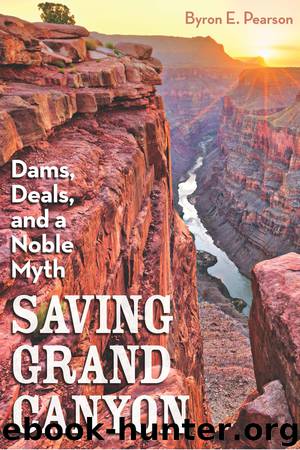Saving Grand Canyon by Byron E Pearson

Author:Byron E Pearson
Language: eng
Format: epub
ISBN: 9781948908320
Publisher: University of Nevada Press
7
“Permanent Massive Things”
At the outset of the new year, environmentalists and supporters of the Grand Canyon dams were still honing strategies to win the day in Congress and to convince the American people to support them. Which side would prevail—those who wanted to continue developing the West’s water resources to support skyrocketing population growth and develop new recreational opportunities, or advocates of preservation who fought to preserve the free-flowing Colorado River in a stretch of Grand Canyon few people would ever see? Would the outcome reflect progress as it had been defined since the founding of the nation, or would it reflect progress of a different sort—a recognition that intangible aesthetic values were sometimes worth more than dollars and cents?1
Was there still a place in such a wealthy country for John Muir–style preservation, or could this affluence only be sustained by continuing to sacrifice America’s natural grandeur? Could technology save the day and allow America to have both? In the firmament of the mid-1960s, with the nation more divided than at any time since the Civil War, how the fight to save Grand Canyon would be affected by the civil rights movement, concerns about free speech, protests against American intervention in Vietnam, and the rising tide of the new environmentalism, was impossible to predict.
As American society grappled with these and other issues, the political process continued to grind forward. Morris Udall, John Rhodes, Carl Hayden, Stewart Udall, Barry Goldwater, and others who were attempting to gain passage of the Central Arizona Project waited impatiently for Wayne Aspinall to reconvene the House hearings that had ended the previous year. All hoped that the seven states of the Colorado River Basin would honor the compromises, so painstakingly negotiated during the previous two years, long enough for the bill to reach the floor of the House for a vote.
Although hundreds of people were working on obtaining passage of the Central Arizona Project bill, by January 1966 Morris Udall emerged as the quarterback of the effort in the House. Mo Udall, the “one-eyed Mormon” as he laughingly referred to himself, took office in May 1961 upon winning a special election for his brother’s vacant congressional seat, after Stewart’s appointment as interior secretary. Twice reelected, he now held Arizona’s only seat on the vital House Committee on Interior and Insular Affairs. Generally a supporter of conservation, in the case of CAP, Morris Udall found himself caught in the same conundrum as his brother. He found himself opposing conservationists with whom he was usually allied, all the while fighting a personal struggle to reconcile his obligations to his Arizona constituency and his desire to develop Arizona’s water resources with his own environmentalist sympathies. Possessed of a self-deprecating wit, by 1966 Morris Udall also was known among his colleagues as a politician of keen intellect with a tireless work ethic, a man who was not above playing hardball politics when the situation called for it.2
Jackson and the Hualapai: Removing the Roadblocks
Potential opposition from the Pacific Northwest still threatened the Central Arizona Project bill, especially in the Senate.
Download
This site does not store any files on its server. We only index and link to content provided by other sites. Please contact the content providers to delete copyright contents if any and email us, we'll remove relevant links or contents immediately.
The Secret History by Donna Tartt(18936)
The Social Justice Warrior Handbook by Lisa De Pasquale(12163)
Thirteen Reasons Why by Jay Asher(8833)
This Is How You Lose Her by Junot Diaz(6829)
Weapons of Math Destruction by Cathy O'Neil(6204)
Zero to One by Peter Thiel(5728)
Beartown by Fredrik Backman(5665)
The Myth of the Strong Leader by Archie Brown(5451)
The Fire Next Time by James Baldwin(5377)
How Democracies Die by Steven Levitsky & Daniel Ziblatt(5168)
Promise Me, Dad by Joe Biden(5110)
Stone's Rules by Roger Stone(5050)
A Higher Loyalty: Truth, Lies, and Leadership by James Comey(4901)
100 Deadly Skills by Clint Emerson(4875)
Rise and Kill First by Ronen Bergman(4736)
Secrecy World by Jake Bernstein(4697)
The David Icke Guide to the Global Conspiracy (and how to end it) by David Icke(4653)
The Farm by Tom Rob Smith(4463)
The Doomsday Machine by Daniel Ellsberg(4446)
